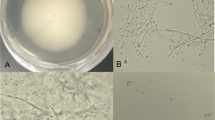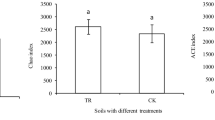Abstract
This study investigated the effects of root-knot nematode biocontrol agent Paecilomyces lilacinus (P. lilacinus) strain PL1210 on ammonia-oxidizing microorganisms and fungal community composition of tomato rhizosphere. The exchangeable NH4 +-N and NO3 −-N contents were lower in inoculated soils than in the control during 60 days of incubation. Real-time quantitative polymerase chain reaction (qPCR) detected stable colonization of P. lilacinus in the tomato rhizosphere and significant inhibition of ammonia-oxidizing bacteria (AOB) and archaea (AOA), which could be responsible for the decrease of NO3 −-N content in soil. PCR-denaturing gradient gel electrophoresis (DGGE) analysis demonstrated no significant difference in soil fungal community composition associated with the application of P. lilacinus as shown by Shannon–Wiener diversity index (H′) and Margalef index (D). Cluster analysis showed that the composition of rhizosphere fungal community was more significantly influenced by time-related differences than by the inoculation of biocontrol agents.





Similar content being viewed by others

References
Atkins SD, Clark IM, Pande S, Hirsch PR, Kerry BR (2005) The use of real-time PCR and species-specific primers for the identification and monitoring of Paecilomyces lilacinus. FEMS Microbiol Ecol 51:257–264
Bais HP, Weir TL, Perry LG, Gilroy S, Vivanco JM (2006) The role of root exudates in rhizosphere interactions with plants and other organisms. Annu Rev Plant Biol 57:233–266
Bankhead SB, Landa BB, Lutton E, Weller DM, Gardener BB (2004) Minimal changes in rhizobacterial population structure following root colonization by wild type and transgenic biocontrol strains. FEMS Microbiol Ecol 49:307–318
Bardgett RD, Lovell RD, Hobbs PJ, Jarvis SC (1999) Seasonal changes in soil microbial communities along a fertility gradient of temperate grasslands. Soil Biol Biochem 31:1021–1030
Buee M, De Boer W, Martin F, van Overbeek L, Jurkevitch E (2009) The rhizosphere zoo: an overview of plant-associated communities of microorganisms, including phages, bacteria, archaea, and fungi, and of some of their structuring factors. Plant Soil 321:189–212
Cabanillas E, Barker KR, Nelson LA (1989) Growth of isolates of Paecilomyces lilacinus and their efficacy in biocontrol of Meloidogyne incognita on tomato. J Nematol 21:164–172
Chen X, Zhang LM, Shen JP, Wei WX, He JZ (2011) Abundance and community structure of ammonia-oxidizing archaea and bacteria in an acid paddy soil. Biol Fertil Soils 47:323–331
Cui H, Wang SP, Fu J, Zhou ZQ, Zhang N, Guo L (2014) Influence of ciprofloxacin on microbial community structure and function in soils. Biol Fertil Soils 50:939–947
Cycon M, Piotrowska-Seget Z (2009) Changes in bacterial diversity and community structure following pesticides addition to soil estimated by cultivation technique. Ecotoxicology 18:632–642
De Curtis F, de Felice DV, Ianiri G, De Cicco V, Castoria R (2012) Environmental factors affect the activity of biocontrol agents against ochratoxigenic Aspergillus carbonarius on wine grape. Int J Food Microbiol 159:17–24
Fan FL, Zhang FS, Lu YH (2011) Linking plant identity and interspecific competition to soil nitrogen cycling through ammonia oxidizer communities. Soil Biol Biochem 43:46–54
Fuka MM, Engel M, Hagn A, Munch JC, Sommer M, Schloter M (2009) Changes of Diversity pattern of proteolytic bacteria over time and space in an agricultural soil. Microb Ecol 57:391–401
Gao JF, Luo X, Wu GX, Li T, Peng YZ (2013) Quantitative analyses of the composition and abundance of ammonia-oxidizing archaea and ammonia-oxidizing bacteria in eight full-scale biological wastewater treatment plants. Bioresour Technol 138:285–296
Garbeva P, van Veen JA, van Elsas JD (2004) Microbial diversity in soil: selection microbial populations by plant and soil type and implications for disease suppressiveness. Annu Rev Phytopathol 42:243–270
Geisseler D, Horwath WR, Joergensen RG, Ludwig B (2010) Pathways of nitrogen utilization by soil microorganisms—a review. Soil Biol Biochem 42:2058–2067
Georgiev G, Hubenov Z, Georgieva M, Mirchev P, Matova M, Solter LF, Pilarska D (2013) Interactions between the introduced fungal pathogen Entomophaga maimaiga and indigenous tachinid parasitoids of gypsy moth Lymantria dispar in Bulgaria. Phytoparasitica 41:125–131
Grosch R, Scherwinski K, Lottmann J, Berg G (2006) Fungal antagonists of the plant pathogen Rhizoctonia solani: selection, control efficacy and influence on the indigenous microbial community. Mycol Res 110:1464–1474
Hashem M, Abo-Elyousr KA (2011) Management of the root-knot nematode Meloidogyne incognita on tomato with combinations of different biocontrol organisms. Crop Prot 30:285–292
He J, Shen J, Zhang L, Zhu Y, Zheng Y, Xu M, Di HJ (2007) Quantitative analyses of the abundance and composition of ammonia-oxidizing bacteria and ammonia-oxidizing archaea of a Chinese upland red soil under long-term fertilization practices. Environ Microbiol 9:2364–2374
Holland RJ, Williams KL, Khan A (1999) Infection of Meloidogyne javanica by Paecilomyces lilacinus. Nematology 1:131–139
Huang WK, Sun JH, Cui JK, Wang GF, Kong LA, Peng H, Chen SL, Peng DL (2014a) Efficacy evaluation of fungus Syncephalastrum racemosum and nematicide avermectin against the root-knot nematode Meloidogyne incognita on cucumber. PLoS One 9:e89717
Huang XF, Chaparro JM, Reardon KF, Zhang RF, Shen QR, Vivanco JM (2014b) Rhizosphere interactions: root exudates, microbes, and microbial communities. Botany-Botanique 92:267–275
Isaka M, Palasarn S, Lapanun S, Sriklung K (2007) Paecilodepsipeptide A, an antimalarial and antitumor Cyclohexadepsipeptide from the insect pathogenic fungus Paecilomyces cinnamomeus BCC 9616. J Nat Prod 70:675–678
Janczyk P, Pieper R, Smidt H, Souffrant WB (2007) Changes in the diversity of pig ileal lactobacilli around weaning determined by means of 16S rRNA gene amplification and denaturing gradient gel electrophoresis. FEMS Microbiol Ecol 61:132–140
Kalele DN, Affokpon A, Coosemans J (2007) Efficacy of Paecilomyces lilacinus strain 251 against root knot nematodes in tomato under greenhouse conditions. Commun Agric Appl Biol Sci 72:209–213
Kastl E-M, Schloter-Hai B, Buegger F, Schloter M (2014) Impact of fertilization on the abundance of nitrifiers and denitrifiers at the root–soil interface of plants with different uptake strategies for nitrogen. Biol Fertil Soils. doi:10.1007/s00374-014-0948-1
Kennedy N, Brodie E, Connolly J, Clipson N (2006) Seasonal influences on fungal community structure in unimproved and improved upland grassland soils. Can J Microbiol 52:689–694
Kiewnick S, Sikora RA (2006) Biological control of the root-knot nematode Meloidogyne incognita by Paecilomyces lilacinus strain 251. Biol Control 38:179–187
Kiewnick S, Neumann S, Sikora RA, Frey JE (2011) Effect of Meloidogyne incognita inoculum density and application rate of Paecilomyces lilacinus strain 251 on biocontrol efficacy and colonization of egg masses analyzed by real-time quantitative PCR. Phytopathology 101:105–112
Kotzerke A, Fulle M, Sharma S, Kleineidam K, Welzl G, Lamshoft M, Schloter M, Wilke BM (2011) Alterations in total microbial activity and nitrification rates in soil due to amoxicillin-spiked pig manure. J Plant Nutr Soil Sci 174:56–64
Masto RE, Chhonkar PK, Purakayastha TJ, Patra AK, Singh D (2008) Soil quality indices for evaluation of long-term land use and soil management practices in semi-arid sub-tropical India. Land Degrad Dev 19:516–529
Mikami Y, Yazawa K, Fukushima K, Arai T, Udagawa S, Samson RA (1989) Paecilotoxin production in clinical or terrestrial isolates of Paecilomyces lilacinus strains. Mycopathologia 108:195–199
Morton CO, Hirsch PR, Kerry BR (2004) Infection of plant-parasitic nematodes by nematophagous fungi—a review of the application of molecular biology to understand infection processes and to improve biological control. Nematology 6:161–170
Nannipieri P, Ascher J, Ceccherini MT, Landi L, Pietramellara G, Renella G (2003) Microbial diversity and soil functions. Eur J Soil Sci 54:655–670
Oka Y, Shuker S, Tkachi N (2009) Nematicidal efficacy of MCW-2, a new nematicide of the fluoroalkenyl group, against the root-knot nematode Meloidogyne javanica. Pest Manag Sci 65:1082–1089
Palacios OA, Bashan Y, de-Bashan LE (2014) Proven and potential involvement of vitamins in interactions of plants with plant growth-promoting bacteria—an overview. Biol Fertil Soils 50:415–432
Qin HL, Yuan HZ, Zhang H, Zhu YJ, Yin CM, Tan ZJ, Wu JS, Wei WX (2013) Ammonia-oxidizing archaea are more important than ammonia-oxidizing bacteria in nitrification and NO3 (−)-N loss in acidic soil of sloped land. Biol Fertil Soils 49:767–776
Qiu MH, Li SQ, Zhou X, Cui XS, Vivanco JM, Zhang N, Shen QR, Zhang RF (2014) De-coupling of root-microbiome associations followed by antagonist inoculation improves rhizosphere soil suppressiveness. Biol Fertil Soils 50:217–224
Ritz B, Rull RP (2008) Assessment of environmental exposures from agricultural pesticides in childhood leukaemia studies: challenges and opportunities. Radiat Prot Dosim 132:148–155
Shi YC, Lalande R, Hamel C, Ziadi N, Gagnon B, Hu ZY (2013) Seasonal variation of microbial biomass, activity, and community structure in soil under different tillage and phosphorus management practices. Biol Fertil Soils 49:803–818
Siddiqui ZA, Futai K (2009) Biocontrol of Meloidogyne incognita on tomato using antagonistic fungi, plant-growth-promoting rhizobacteria and cattle manure. Pest Manag Sci 65:943–948
Spellerberg IF, Fedor PJ (2003) A tribute to Claude Shannon (1916–2001) and a plea for more rigorous use of species richness, species diversity and the ‘Shannon-Wiener’ Index. Glob Ecol Biogeogr 12:177–179
Stirling G, Wilsey B (2001) Empirical relationships between species richness, evenness, and proportional diversity. Am Nat 158:286–299
Teles AP, Takahashi JA (2013) Paecilomide, a new acetylcholinesterase inhibitor from Paecilomyces lilacinus. Microbiol Res 168:204–210
Voriskova J, Baldrian P (2013) Fungal community on decomposing leaf litter undergoes rapid successional changes. ISME J 7:477–486
Wang F, Yao J, Chen H, Chen K, Trebse P, Zaray G (2010a) Comparative toxicity of chlorpyrifos and its oxon derivatives to soil microbial activity by combined methods. Chemosphere 78:319–326
Wang J, Wang J, Liu F, Pan C (2010b) Enhancing the virulence of Paecilomyces lilacinus against Meloidogyne incognita eggs by overexpression of a serine protease. Biotechnol Lett 32:1159–1166
Weng J, Wang Y, Li J, Shen Q, Zhang R (2013) Enhanced root colonization and biocontrol activity of Bacillus amyloliquefaciens SQR9 by abrB gene disruption. Appl Microbiol Biotechnol 97:8823–8830
Winding A, Binnerup SJ, Pritchard H (2004) Non-target effects of bacterial biological control agents suppressing root pathogenic fungi. FEMS Microbiol Ecol 47:129–141
Wu FY, Bi YL, Wong MH (2009) Dual inoculation with an arbuscular Mycorrhizal fungus and Rhizobium to facilitate the growth of Alfalfa on coal mine substrates. J Plant Nutr 32:755–771
Yao H, Gao Y, Nicol GW, Campbell CD, Prosser JI, Zhang L, Han W, Singh BK (2011) Links between ammonia oxidizer community structure, abundance, and nitrification potential in acidic soils. Appl Environ Microbiol 77:4618–4625
Yu HX, Wang CY, Tang M (2013) Fungal and bacterial communities in the rhizosphere of Pinus tabulaeformis related to the restoration of plantations and natural secondary forests in the Loess Plateau, Northwest China. Sci World J 2013:606480
Zhang LM, Offre PR, He JZ, Verhamme DT, Nicol GW, Prosser JI (2010) Autotrophic ammonia oxidation by soil thaumarchaea. Proc Natl Acad Sci U S A 107:17240–17245
Zhang XF, Zhao L, Xu SJ Jr, Liu YZ, Liu HY, Cheng GD (2013a) Soil moisture effect on bacterial and fungal community in Beilu River (Tibetan Plateau) permafrost soils with different vegetation types. J Appl Microbiol 114:1054–1065
Zhang Y, Dong XN, Jiang Z, Cao B, Ge SJ, Hu M (2013b) Assessment of the ecological security of immobilized enzyme remediation process with biological indicators of soil health. Environ Sci Pollut 20:5773–5780
Acknowledgments
This work was supported by the 863 - National High Technology Research and Development Program of China (no. 2012AA06A204-2), National Natured Science Foundation (no. 51176197), Xiamen Science & Technology Major Program (no. 3502Z20131018), and Main Project of Chinese Academy Sciences (KZZD-EW-16).
Conflict of interest
The authors have no conflict of interest to declare.
Author information
Authors and Affiliations
Corresponding author
Rights and permissions
About this article
Cite this article
Yu, Z., Zhang, Y., Luo, W. et al. Root colonization and effect of biocontrol fungus Paecilomyces lilacinus on composition of ammonia-oxidizing bacteria, ammonia-oxidizing archaea and fungal populations of tomato rhizosphere. Biol Fertil Soils 51, 343–351 (2015). https://doi.org/10.1007/s00374-014-0983-y
Received:
Revised:
Accepted:
Published:
Issue Date:
DOI: https://doi.org/10.1007/s00374-014-0983-y



